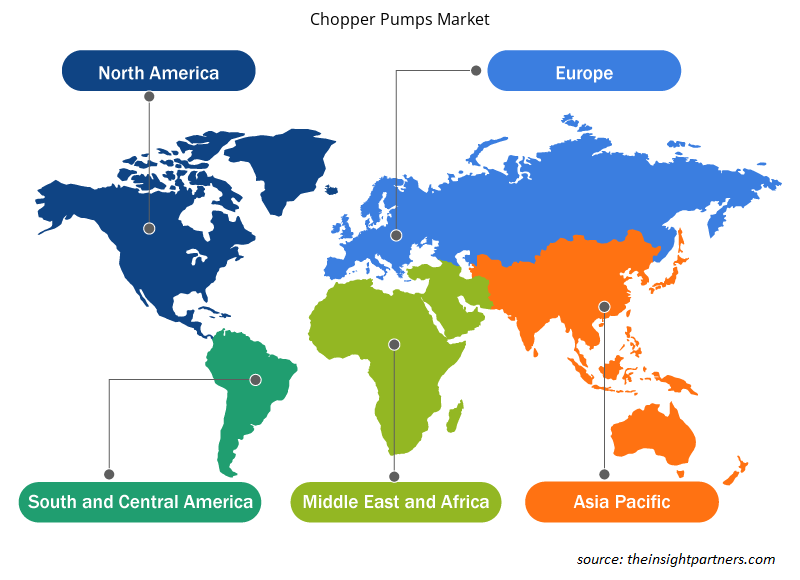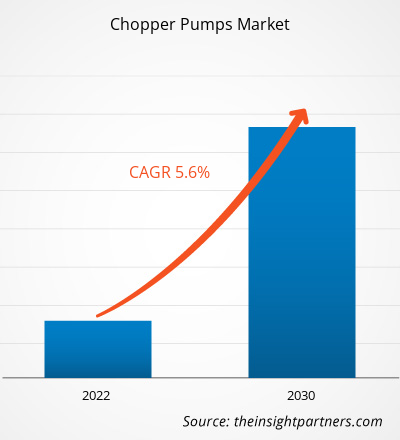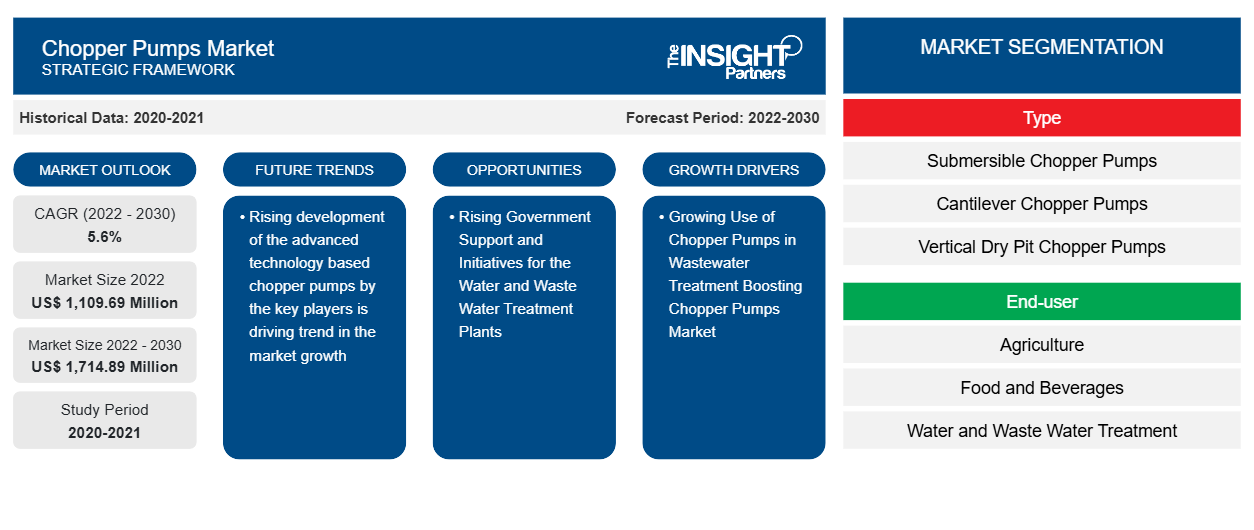Se proyecta que el tamaño del mercado de bombas trituradoras alcance los 1.714,89 millones de dólares estadounidenses para 2030 desde los 1.109,69 millones de dólares estadounidenses en 2022. Se espera que el mercado registre una CAGR del 5,6% en 2022-2030. Es probable que la creciente demanda en varios sectores, incluidos el tratamiento de agua y aguas residuales, alimentos y bebidas y productos químicos, impulse el crecimiento del mercado mundial de bombas trituradoras durante el período de pronóstico. Las bombas trituradoras se utilizan ampliamente en la extracción de aguas residuales de varias plantas en el sector de alimentos y bebidas y productos químicos. El uso de bombas trituradoras está aumentando a un ritmo rápido debido a la creciente demanda de agua reciclada y la creciente escasez de agua. El creciente enfoque en las plantas de tratamiento de agua y aguas residuales con iniciativas gubernamentales y financiación impulsa el crecimiento del mercado de bombas trituradoras.
La creciente demanda de mantenimiento de líneas de alcantarillado adecuadas para reducir la contaminación ambiental está llevando a la aplicación de bombas trituradoras. Las bombas trituradoras tienen la capacidad de manejar desechos sólidos concentrados en varios sectores industriales. La protección ambiental y el creciente apoyo gubernamental para la inversión en plantas de tratamiento de aguas residuales en países europeos como Alemania, el Reino Unido, Francia e Italia son los principales factores impulsores del mercado de bombas trituradoras . Las bombas trituradoras están diseñadas para bombear líquidos altamente contaminados con un alto contenido seco. Estas bombas se utilizan en diferentes verticales de la industria de uso final, como la agricultura, el tratamiento de aguas residuales, los productos químicos, los alimentos y las bebidas.
Análisis del mercado de bombas trituradoras
Las bombas trituradoras tienen una amplia gama de aplicaciones en industrias como el tratamiento de aguas residuales, la acuicultura, el procesamiento de alimentos, la bioenergía, la pulpa y el papel, y el petróleo y el gas. Las bombas trituradoras son adecuadas para bombear residuos sólidos, lodos y grasas de estas industrias, como se mencionó anteriormente. Estas bombas trituradoras tienen un rango de presión de funcionamiento de hasta 6 bar. Por lo tanto, reemplazan a la mayoría de los otros tipos de bombas de desplazamiento.
Descripción general del mercado de bombas trituradoras
Una bomba trituradora no solo bombea los desechos sólidos, sino que mientras bombea, también desmenuza los sólidos en pedazos mucho más pequeños para que puedan pasar a través de la bomba y no obstruir las líneas de desechos desde la bomba hasta el punto terminal posterior. Las bombas trituradoras generalmente se implementan en muchas aplicaciones de alcantarillado, surgiendo como esenciales para varias aplicaciones de aguas residuales. La creciente aplicación de bombas trituradoras en los sectores agrícola e industrial también está impulsando positivamente el crecimiento del mercado de bombas trituradoras. El tipo cambiante de productos de desecho, como toallitas sanitarias , servilletas y mascarillas, también ha impulsado la demanda de bombas trituradoras de alta gama para gestionar los desechos plásticos duros. Los desechos impulsados por plástico son fibrosos, no se disuelven y no son biodegradables. Una bomba trituradora avanzada puede triturar los desechos sólidos altamente concentrados a granel de manera más fina y garantiza que la bomba no se bloquee y que las tuberías adyacentes también estén libres de bloqueos aguas abajo. Europa, América del Norte y Asia Pacífico están mostrando desarrollos positivos en el mercado de bombas trituradoras. Estados Unidos, Alemania y el Reino Unido se encuentran entre los principales países que muestran tendencias de alta demanda a nivel mundial.
Personalice este informe según sus necesidades
Obtendrá personalización en cualquier informe, sin cargo, incluidas partes de este informe o análisis a nivel de país, paquete de datos de Excel, así como también grandes ofertas y descuentos para empresas emergentes y universidades.
-
Obtenga las principales tendencias clave del mercado de este informe.Esta muestra GRATUITA incluirá análisis de datos, desde tendencias del mercado hasta estimaciones y pronósticos.
Impulsores y oportunidades del mercado de bombas trituradoras
El creciente uso de bombas trituradoras en el tratamiento de aguas residuales impulsa el mercado de bombas trituradoras
Los volúmenes de aguas residuales han ido aumentando gradualmente con el tiempo, con el aumento de la población, los avances en el suministro de agua, el aumento de los niveles de vida y el crecimiento económico. Cada año, se producen ~380 mil millones de m3 (metros cúbicos) de aguas residuales municipales en todo el mundo. Los hogares y las industrias generan principalmente aguas residuales. Además, el volumen de aguas residuales también está aumentando en consonancia con el crecimiento de la población. Las aguas residuales y las aguas residuales contienen sustancias tóxicas, productos químicos nocivos y basura relacionada con los estilos de vida de los consumidores contemporáneos. Las aguas residuales transportan contaminantes microbianos, partículas de plástico y residuos de medicamentos que pueden contaminar el agua y afectar la seguridad alimentaria y la salud humana. El problema es grave en áreas densamente pobladas que carecen de instalaciones de tratamiento. Por lo tanto, la creciente necesidad de gestión de aguas residuales está impulsando el mercado de bombas trituradoras.
Creciente apoyo e iniciativas gubernamentales para las plantas de tratamiento de agua y aguas residuales
Los gobiernos de varios países se están centrando en la instalación de instalaciones adecuadas de tratamiento de aguas residuales y cloacales para proteger el medio ambiente de la contaminación. Por ejemplo, en 2022, había más de 16.000 sistemas públicos de tratamiento de aguas residuales en los EE. UU. Más del 80% de la población de EE. UU. obtiene su agua de estos sistemas de agua potable, y aproximadamente el 75% de la población de EE. UU. tiene alcantarillado sanitario tratado por estos sistemas de aguas residuales. La creciente necesidad de controlar la contaminación y utilizar las aguas residuales de una mejor manera después del tratamiento ha sido un factor impulsor importante en el mercado de las bombas trituradoras. Proyectos importantes como la rehabilitación y el reemplazo de la planta de tratamiento de aguas residuales de Noman Cole, la expansión de la planta de tratamiento de aguas residuales de Walnut Creek a 100 MGD, la planta de tratamiento de aguas residuales de South Country One Water Campus, la rehabilitación de la planta de recuperación de agua de Cave Creek y las mejoras preliminares y primarias del tratamiento de FWRC están prestando servicio en los estados de EE. UU. de Texas, Virginia, Florida, Nevada y Arizona. El uso creciente de bombas trituradoras en instalaciones de tratamiento de agua y aguas residuales e infraestructuras de gestión de aguas residuales está liderando el crecimiento del mercado de bombas trituradoras.
Informe de mercado de bombas trituradoras Análisis de segmentación
Los segmentos clave que contribuyeron a la derivación del análisis del mercado de bombas picadoras son el tipo y los usuarios finales.
- Según el tipo, el mercado mundial de bombas trituradoras se divide en bombas trituradoras sumergibles, bombas trituradoras en voladizo, bombas trituradoras verticales para pozo seco, bombas trituradoras autocebantes, bombas trituradoras de succión final y bombas trituradoras verticales para pozo húmedo. Existe una mayor adopción de bombas trituradoras sumergibles en plantas de tratamiento de aguas residuales y aplicaciones agrícolas. Están diseñadas específicamente para respaldar el tratamiento de aguas residuales y agua con materiales en suspensión.
- El mercado de bombas trituradoras sumergibles es altamente competitivo, y las empresas más importantes tienen una participación significativa en los EE. UU. y Europa. Los fabricantes de bombas trituradoras sumergibles se centran en el desarrollo y la expansión de la producción de bombas trituradoras sumergibles para grandes tamaños de descarga y sostenibilidad a largo plazo para garantizar el tratamiento de agua y aguas residuales. Las bombas trituradoras sumergibles ofrecen caudales extraordinariamente altos en comparación con otras bombas y son adecuadas para una amplia gama de aplicaciones de bombeo de líquidos. Como resultado, existe un aumento repentino de la inversión en el desarrollo de bombas trituradoras sumergibles. Algunos de los principales fabricantes en el mercado mundial de bombas trituradoras sumergibles son Vaughan Company, Millennium Pumps, TT Pumps, Xylem, Cornell Pump, EDDY Pump, Landia, Delta Mechanical & Electrical Industries, Hayward Gordon, DeTech Pump, Phoenix Pumps, Witte Pumps & Technology, Chemineer, Gruppo Zenit, Epos PJSC y WAMGROUP SpA, entre otros.
- Según los usuarios finales, el mercado global se divide en agricultura, alimentos y bebidas, tratamiento de agua y aguas residuales, productos químicos y petroquímicos, entre otros. Entre estos, el segmento de tratamiento de agua y aguas residuales está creciendo con la CAGR más alta durante el período de pronóstico.
Análisis de la cuota de mercado de las bombas trituradoras por geografía
El alcance geográfico del informe de mercado de bombas picadoras se divide principalmente en cinco regiones: América del Norte, Asia Pacífico, Europa, Medio Oriente y África, y América del Sur y Central.
Se espera que América del Norte crezca a un ritmo rápido debido a la creciente demanda de plantas de tratamiento de aguas residuales en los EE. UU. Estados Unidos lidera el mercado de bombas trituradoras debido a la creciente aplicación de bombas trituradoras en las instalaciones de tratamiento de aguas residuales. Las bombas trituradoras se utilizan para bombear cobertizos de ordeño y aguas residuales que tienen sólidos en los mataderos. La creciente preocupación por la protección del medio ambiente y la reducción de la degradación del suelo son factores importantes que impulsan la demanda de instalaciones de tratamiento de aguas residuales en todo Estados Unidos. La Agencia de Protección Ambiental de EE. UU. ha emitido Pautas de efluentes y pautas regulatorias nacionales para aguas residuales vertidas a aguas superficiales e instalaciones de tratamiento de aguas residuales municipales. En EE. UU., aproximadamente 16.000 plantas de tratamiento de aguas residuales están operativas al 81% de sus competencias de diseño, mientras que el 15% lo ha logrado o superado en 2022. El aumento de los ecosistemas urbanos indica que se prevé que estas instalaciones se adapten ampliamente para gestionar el requisito de aguas residuales de EE. UU. El creciente número de instalaciones de tratamiento de aguas residuales es otro factor que impulsa el mercado de bombas trituradoras en EE. UU. Además, existe una creciente aplicación de bombas trituradoras en la industria química para mantener la integridad de los procesos químicos y mantener la seguridad de los trabajadores y el medio ambiente en el país.
Perspectivas regionales del mercado de bombas trituradoras
Los analistas de Insight Partners explicaron en detalle las tendencias y los factores regionales que influyen en el mercado de bombas trituradoras durante el período de pronóstico. Esta sección también analiza los segmentos y la geografía del mercado de bombas trituradoras en América del Norte, Europa, Asia Pacífico, Oriente Medio y África, y América del Sur y Central.

- Obtenga datos regionales específicos para el mercado de bombas trituradoras
Alcance del informe de mercado de bombas trituradoras
| Atributo del informe | Detalles |
|---|---|
| Tamaño del mercado en 2022 | US$ 1.109,69 millones |
| Tamaño del mercado en 2030 | US$ 1.714,89 millones |
| CAGR global (2022-2030) | 5,6% |
| Datos históricos | 2020-2021 |
| Período de pronóstico | 2022-2030 |
| Segmentos cubiertos |
Por tipo
|
| Regiones y países cubiertos |
América del norte
|
| Líderes del mercado y perfiles de empresas clave |
|
Densidad de actores del mercado: comprensión de su impacto en la dinámica empresarial
El mercado de bombas trituradoras está creciendo rápidamente, impulsado por la creciente demanda de los usuarios finales debido a factores como la evolución de las preferencias de los consumidores, los avances tecnológicos y una mayor conciencia de los beneficios del producto. A medida que aumenta la demanda, las empresas amplían sus ofertas, innovan para satisfacer las necesidades de los consumidores y aprovechan las tendencias emergentes, lo que impulsa aún más el crecimiento del mercado.
La densidad de actores del mercado se refiere a la distribución de las empresas o firmas que operan dentro de un mercado o industria en particular. Indica cuántos competidores (actores del mercado) están presentes en un espacio de mercado determinado en relación con su tamaño o valor total de mercado.
Las principales empresas que operan en el mercado de bombas trituradoras son:
- Compañía Vaughan
- Bombas Millennium
- Bombas TT
- Xilema
- Bomba de Cornell
- Bomba EDDY
Descargo de responsabilidad : Las empresas enumeradas anteriormente no están clasificadas en ningún orden particular.

- Obtenga una descripción general de los principales actores clave del mercado de bombas Chopper
Noticias y desarrollos recientes del mercado de bombas trituradoras
El mercado de bombas trituradoras se evalúa mediante la recopilación de datos cualitativos y cuantitativos posteriores a la investigación primaria y secundaria, que incluye publicaciones corporativas importantes, datos de asociaciones y bases de datos. A continuación, se incluye una lista de los avances en el mercado en materia de innovaciones, expansión comercial y estrategias:
- En abril de 2024, Sulzer inauguró su nueva planta de producción en Easley, Carolina del Sur, EE. UU. La nueva planta de fabricación consta de tecnologías y procesos de última generación para la fabricación de trituradoras sumergibles y bombas para aguas residuales. Sulzer invirtió más de 11 millones de dólares para ampliar su capacidad de producción utilizando la avanzada planta de fabricación en EE. UU. Con esta expansión, Sulzer fortaleció su cadena de suministro en EE. UU. para ofrecer una amplia gama de productos que cumplen con la Ley Buy America (BABA) de Build America. (Fuente: Eurofins, comunicado de prensa)
- En 2023, Sulzer firmó un acuerdo con JTC Corp para construir un nuevo centro de investigación para sus soluciones de tecnología de separación. La nueva instalación está ubicada en el CleanTech Park del Distrito de Innovación de Jurong, el primer parque empresarial ecológico de Singapur diseñado específicamente para respaldar soluciones urbanas y de fabricación limpias y sostenibles. (Fuente: SGS, Newsletter)
Informe de mercado de bombas trituradoras: cobertura y resultados
El informe “Tamaño y pronóstico del mercado de bombas picadoras (2020-2030)” proporciona un análisis detallado del mercado que cubre las siguientes áreas:
- Tamaño del mercado de bombas trituradoras y pronóstico a nivel global, regional y nacional para todos los segmentos clave del mercado cubiertos bajo el alcance
- Dinámica del mercado, como impulsores, restricciones y oportunidades clave
- Tendencias del mercado de bombas trituradoras
- Análisis PEST detallado y análisis FODA
- Análisis del mercado de bombas trituradoras que cubre las tendencias clave del mercado, el marco global y regional, los principales actores, las regulaciones y los desarrollos recientes del mercado.
- Panorama de la industria del mercado de bombas picadoras y análisis de la competencia que cubre la concentración del mercado, análisis de mapas de calor, actores destacados y desarrollos recientes.
- Perfiles detallados de empresas
- Análisis histórico (2 años), año base, pronóstico (7 años) con CAGR
- Análisis PEST y FODA
- Tamaño del mercado, valor/volumen: global, regional y nacional
- Industria y panorama competitivo
- Conjunto de datos de Excel
Informes recientes
Informes relacionados
Testimonios
Razón para comprar
- Toma de decisiones informada
- Comprensión de la dinámica del mercado
- Análisis competitivo
- Información sobre clientes
- Pronósticos del mercado
- Mitigación de riesgos
- Planificación estratégica
- Justificación de la inversión
- Identificación de mercados emergentes
- Mejora de las estrategias de marketing
- Impulso de la eficiencia operativa
- Alineación con las tendencias regulatorias























 Obtenga una muestra gratuita para - Mercado de bombas trituradoras
Obtenga una muestra gratuita para - Mercado de bombas trituradoras